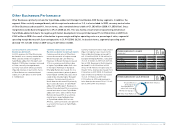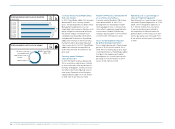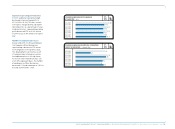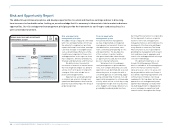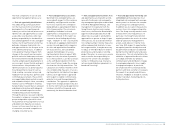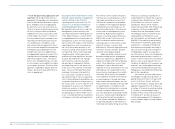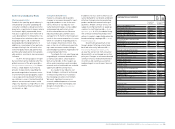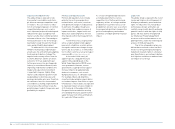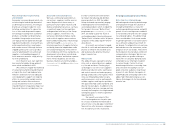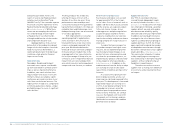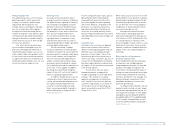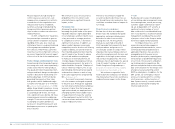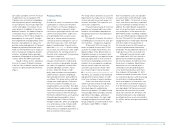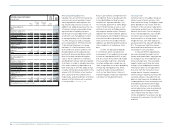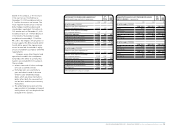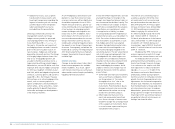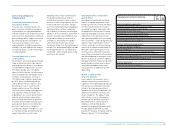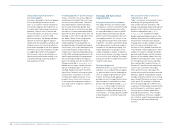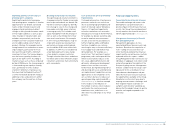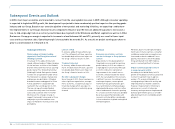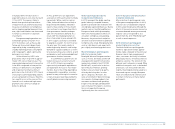Reebok 2009 Annual Report Download - page 151
Download and view the complete annual report
Please find page 151 of the 2009 Reebok annual report below. You can navigate through the pages in the report by either clicking on the pages listed below, or by using the keyword search tool below to find specific information within the annual report.
GROUP MANAGEMENT REPORT – FINANCIAL REVIEW Risk and Opportunity Report 147
Product quality risks
The adidas Group faces a risk of selling
defective products, which may result
in injury to consumers and/or image
impairment. We mitigate this risk
through rigorous testing prior to produc-
tion, close cooperation with suppliers
throughout the manufacturing process,
random testing after retail delivery, open
communication about defective products
and quick settlement of product liability
claims when necessary. In 2009, we did
not recall any products.
Our assessment of product qual-
ity risk remains unchanged versus the
prior year. We regard the likelihood of
significant product liability cases or hav-
ing to conduct wide-scale product recalls
as low. As we have insurance protecting
us against the financial consequences of
significant product liability cases, we also
assess the financial impact as low.
Inventory risks
As we place initial production orders
around six months in advance of delivery,
the adidas Group is exposed to inventory
risks relating to misjudging consumer
demand at the time of production plan-
ning. A sudden decline in demand has
the potential to cause excess inventories.
This can have negative implications
for our financial performance, includ-
ing higher levels of clearance activity
and inventory obsolescence as well as
reduced liquidity due to higher operating
working capital requirements.
On the other hand, a sudden
increase in demand can lead to product
shortfalls at the point of sale for both our
wholesale partners and own-retail opera-
tions. In this situation, our Group faces
the risk of missed sales opportunities
and/or customer and consumer disap-
pointment, which could lead to a reduc-
tion in brand loyalty and our reputation as
an on-time, in-full supplier. In addition,
the Group faces potential profitability
impacts from costs such as air freight in
efforts to speed up replenishment.
In order to mitigate these risks, we
continuously strive to improve our fore-
casting and material planning processes.
Our replenishment programmes are
essential to shorten production lead
times, ensuring availability of products
while avoiding excess inventories see
Global Operations, p. 88.
In 2010, compared to prior years, precise
demand and inventory planning will
remain difficult, given the lack of clar-
ity on how rapidly consumer spending
will recover. However, compared to the
prior year, our inventory situation has
improved substantially. Therefore, we
assess the associated inventory risk as
having a medium likelihood of occurrence
and medium potential financial impact on
our Group.
Customer risks
Customer risks arise from our depend-
ence on key customers who have the
ability to exert bargaining power and can
therefore cause considerable margin
pressure or cancel orders. These risks
exist not only due to the relative size of
some of our major customers, but also as
a result of our limited ability to influence
how they conduct business and the exter-
nal impacts of the consumer environment
in which they operate.
To limit these risks, we utilise
a broad distribution strategy which
includes expanding our controlled space
activities. This enables us to reduce
negative consequences resulting from
sales shortfalls that can occur with key
customers. Specifically, no customer of
our Group or any of our operating seg-
ments accounted for more than 10% of
Group sales in 2009.
When necessary, we also restrict or limit
the distribution of our products to protect
brand image or product margins. By dif-
ferentiating our product offer to custom-
ers, we limit the risk of increased price
competition on specific products which
can result in margin erosion.
Although the economic environ-
ment remains challenging, given the
operational improvements taken by sev-
eral retailers in 2009, we believe the risk
of a strong reduction of business with
one of our biggest retailers now has a low
likelihood of occurrence. Such an event,
however, could have a medium financial
impact on the sales and profitability of
the Group.
Risks from loss of key event or
promotion partnerships
Event and promotion partnerships play
an important role in building brand
image and generating sales of licensed
products. The adidas Group faces the
risk of either losing key partnerships or
having to accept unfavourable terms due
to intensified competition for attractive
contracts. During 2009, for example, the
National Olympic Committee of China
and adidas decided not to renew their
promotion partnership.
To mitigate these inherent risks, we
regularly seek to extend our most impor-
tant partnership agreements before con-
tract expiry. For example, in 2009 adidas
extended its partnership with UEFA for
the UEFA EURO 2012™ and UEFA EURO
2016™ football championships, as well
as for the UEFA Champions League see
adidas Strategy, p. 60.


